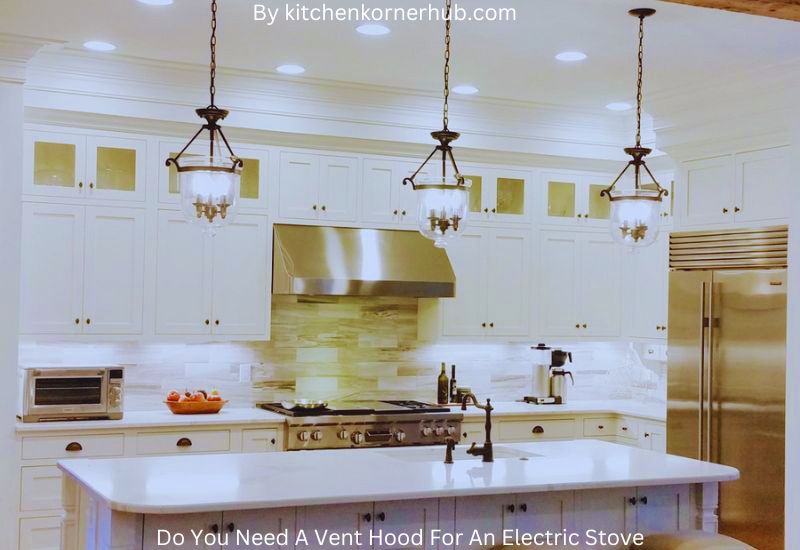Are you wondering if you should have a vent hood for your electric stove? Well, you’re not alone! Many folks cooking up a storm in their kitchens have pondered this question. A vent hood, also known as a range hood, is like the unsung hero of your cooking space. It’s that big contraption hanging above your stove that sucks up all the smoke, steam, and odors when you cook. But do you really need one if you have an electric stove?
Do You Need A Vent Hood For An Electric Stove? No, you do not typically need a vent hood for an electric stove since electric stoves produce less heat and combustion byproducts compared to gas stoves. However, using a vent hood can help eliminate cooking odors and improve indoor air quality, but it’s not a necessity for safety reasons as with gas stoves.
Let’s dive into this topic and uncover whether a vent hood is a must-have or just a nice-to-have for your kitchen. We’ll explore the benefits, alternatives, and considerations to help you make an informed decision. So, whether you’re a seasoned chef or just starting your culinary journey, stick around to find out if that vent hood is worth the investment for your electric stove setup. Let’s clear the air and get cooking!
Understanding Vent Hoods for Electric Stoves

Introduction: Vent hoods play a crucial role in maintaining a clean and healthy kitchen environment, especially when it comes to electric stoves. These appliances are designed to remove smoke, odors, and grease particles generated during cooking. In this comprehensive note, we will delve into the intricacies of vent hoods for electric stoves, exploring their types, benefits, installation, maintenance, and factors to consider when choosing the right one for your kitchen.
Types of Vent Hoods:
There are several types of vent hoods available for electric stoves, each with its own unique features. Wall-mounted vent hoods, which are installed against the wall above the stove, are common in many kitchens. Island vent hoods are ideal for kitchen islands and cooktops located away from walls. Downdraft vent systems, on the other hand, are integrated into the cooktop and rise when needed. Understanding these different types will help you choose the one that best suits your kitchen layout and needs.
Benefits of Vent Hoods:
Vent hoods offer numerous advantages for electric stove users. They efficiently remove cooking byproducts such as smoke, steam, and grease, thereby improving indoor air quality and preventing the buildup of harmful airborne particles. In addition to enhancing the kitchen’s overall cleanliness, vent hoods also help reduce the risk of fire hazards by eliminating excess heat and fumes. Moreover, they contribute to a more comfortable cooking experience by minimizing odors and preventing the spread of cooking aromas throughout the house.
Installation and Proper Placement:
Proper installation of a vent hood is crucial to ensure its optimal performance. It’s essential to place the vent hood at the correct height above the stove to capture cooking emissions effectively. Typically, the ideal distance is around 24 to 30 inches above the cooktop surface. Additionally, the vent hood’s exhaust should be correctly routed to the outside to expel pollutants, rather than recirculating them indoors. Professional installation by a licensed technician is recommended to ensure safety and efficiency.
Maintenance and Cleaning:
To maintain the efficiency of your vent hood, regular cleaning is essential. Grease and debris can accumulate in the filters and ducts, reducing its effectiveness over time. Most vent hoods come with removable, dishwasher-safe filters that should be cleaned or replaced as needed. It’s also important to wipe down the exterior surfaces regularly and inspect the ductwork for any obstructions or damage. Proper maintenance ensures that your vent hood continues to function optimally and prolongs its lifespan.
Factors to Consider When Choosing a Vent Hood:
When selecting a vent hood for your electric stove, consider factors such as the stove’s size and cooking style, the kitchen’s layout, and your budget. Opt for a vent hood with adequate airflow capacity to match your stove’s output. Noise level is another consideration, as some vent hoods can be quite loud. Energy efficiency and aesthetics are also important factors to weigh, as your choice should complement the overall kitchen design and save on energy costs.
Advantages of Using a Vent Hood with Your Electric Stove

Cooking is an integral part of our daily lives, and for many of us, electric stoves have become the preferred choice due to their efficiency and convenience. However, pairing your electric stove with a vent hood offers numerous advantages that enhance your cooking experience and improve the overall environment in your kitchen.
Efficient Smoke and Odor Removal:
One of the primary benefits of using a vent hood with your electric stove is its ability to efficiently remove smoke, steam, and cooking odors from your kitchen. As you cook, especially when frying or grilling, smoke and odors can linger in the air, making your kitchen uncomfortable and potentially leaving a lasting smell in your home. A vent hood helps by capturing these pollutants at the source and expelling them outside, keeping your kitchen air clean and fresh.
Improved Indoor Air Quality:
Cooking can release various airborne particles, including grease, carbon monoxide, and volatile organic compounds (VOCs), which can be harmful if inhaled in large quantities. Vent hoods equipped with effective filters help to reduce these pollutants, thus enhancing the overall indoor air quality in your home. This is particularly important for individuals with respiratory issues or allergies.
Fire Safety:
Another significant advantage of using a vent hood with your electric stove is fire safety. Electric stoves may not produce open flames, but they can still generate high heat levels. Accidental fires can occur if cooking oils or food items become overheated. A vent hood can mitigate this risk by quickly removing excess heat and preventing the spread of flames or smoke.
Reduced Cleaning Efforts:
Cooking without a vent hood often results in a buildup of grease and grime on kitchen surfaces and appliances. Over time, this can be challenging to clean and may even damage your kitchen cabinets and walls. Vent hoods help reduce the accumulation of grease by trapping it in filters, making cleaning your kitchen much easier and less frequent.
Enhanced Comfort and Temperature Control:
A vent hood not only removes smoke and odors but also helps control the temperature in your kitchen. By expelling hot air generated during cooking, it prevents your kitchen from becoming excessively hot and uncomfortable. This is particularly beneficial during the summer months when cooking can heat up your living space.
The Importance of Ventilation in Your Kitchen

Introduction: The kitchen is often considered the heart of the home, where delicious meals are prepared, and cherished memories are made. However, it’s essential to understand that the kitchen is also a place where various pollutants and odors can accumulate. This is where kitchen ventilation comes into play, as it plays a vital role in maintaining a healthy and comfortable living environment. In this article, we’ll delve into the importance of kitchen ventilation and why it should be a top priority for every homeowner.
Eliminating Unwanted Odors:
One of the primary benefits of kitchen ventilation is its ability to swiftly remove unwanted cooking odors. While cooking, various aromas and fumes are released, some of which can be quite pungent. Without proper ventilation, these odors can linger in your home, affecting its overall air quality. A well-designed range hood or exhaust fan can effectively whisk away these odors, ensuring your home always smells fresh.
Removing Harmful Pollutants:
Cooking, especially when using gas stoves, can release harmful pollutants like carbon monoxide and nitrogen dioxide. These gases can be detrimental to your health if not properly vented. A kitchen ventilation system equipped with a powerful exhaust fan can help remove these pollutants, safeguarding your family’s well-being. It’s especially crucial for homes with gas appliances to have effective ventilation in the kitchen.
Controlling Moisture and Humidity:
Another crucial aspect of kitchen ventilation is its ability to control moisture and humidity levels. While cooking, steam and moisture are released into the air, which can lead to mold growth, water damage, and deteriorating indoor air quality. A properly functioning range hood or exhaust fan helps maintain optimal humidity levels, preventing these issues and preserving your home’s structural integrity.
Enhancing Comfort:
A well-ventilated kitchen contributes to a more comfortable cooking environment. It reduces heat buildup, making it more pleasant to work in the kitchen, especially during hot summer months. Additionally, proper ventilation prevents the accumulation of smoke, grease, and particulate matter, keeping your kitchen cleaner and more enjoyable to use.
Protecting Your Investment:
Investing in a high-quality kitchen ventilation system can also protect your valuable kitchen appliances and cabinetry. Cooking releases grease and oils into the air, which can settle on surfaces and cause long-term damage. An effective range hood or exhaust fan helps prevent the buildup of grease, extending the lifespan of your kitchen equipment and maintaining its aesthetic appeal.
Do Electric Stoves Produce Enough Smoke and Fumes to Require a Vent Hood?

Introduction: Electric stoves have become increasingly popular in modern kitchens due to their energy efficiency and ease of use. Unlike their gas counterparts, electric stoves do not produce an open flame, which raises the question of whether they generate enough smoke and fumes to necessitate the installation of a vent hood. In this comprehensive note, we’ll explore the various factors that determine whether an electric stove requires a vent hood.
The Nature of Electric Stove Cooking:
Electric stoves primarily rely on electric coils or induction elements to generate heat. These elements are known for their efficiency in heating cookware directly, resulting in less smoke and fumes being generated during cooking. Unlike gas stoves, which emit combustion byproducts like carbon monoxide and nitrogen dioxide, electric stoves produce fewer harmful emissions.
Cooking Methods Matter:
The type of cooking you do on your electric stove plays a significant role in determining the need for a vent hood. While simple tasks like boiling water or reheating leftovers produce minimal smoke and fumes, high-heat cooking methods such as searing and deep-frying can generate more substantial amounts of smoke and grease particles. If you frequently engage in these techniques, a vent hood may be beneficial.
Kitchen Ventilation:
Another crucial factor is the existing ventilation in your kitchen. If your kitchen is well-ventilated with open windows or an efficient exhaust system, it can help disperse any smoke or fumes generated by your electric stove. Adequate ventilation can reduce the need for a dedicated vent hood, especially if you only occasionally cook dishes that produce significant smoke.
Health and Indoor Air Quality:
Consider the health implications of cooking without proper ventilation. While electric stoves are generally cleaner than gas stoves, prolonged exposure to cooking fumes, especially from high-heat methods, can still have adverse effects on indoor air quality. Installing a vent hood can help maintain a healthier and more comfortable cooking environment, reducing the risk of respiratory issues.
Kitchen Aesthetics and Preferences:
Finally, personal preferences and the aesthetics of your kitchen should also influence your decision. Vent hoods come in various designs, from sleek and modern to traditional styles. Some homeowners may choose to install a vent hood purely for its aesthetic value or as a design element in their kitchen, even if the cooking methods don’t generate excessive smoke or fumes.
Alternative Kitchen Ventilation Options for Electric Stoves

Introduction: Proper kitchen ventilation is essential to maintain a clean and healthy indoor environment. While traditional range hoods have long been the go-to choice for venting smoke, odors, and grease produced during cooking, there are alternative ventilation options that can be just as effective, especially for electric stoves. In this article, we will explore these alternative options that not only provide efficient ventilation but also add a touch of innovation to your kitchen space.
Recirculating Range Hoods:
Recirculating range hoods are a viable option for homes without access to external ventilation ducts. These hoods work by filtering the air through a series of charcoal or activated carbon filters, which trap impurities and odors before recirculating clean air back into the kitchen. While they may not be as efficient as ducted hoods in removing heat and moisture, they are an excellent choice for apartments or kitchens where duct installation is challenging.
Downdraft Ventilation Systems:
Downdraft ventilation systems are a sleek and space-saving option that retracts into the countertop when not in use. They are especially suitable for kitchen islands with electric stoves. When cooking, the system rises and captures smoke, steam, and odors directly from the cooking surface. The air is then drawn down and expelled through an external duct or filtered and recirculated back into the kitchen. Downdraft systems offer a minimalist aesthetic and can be an excellent choice for modern kitchen designs.
Ceiling-Mounted Extractors:
Ceiling-mounted extractors, also known as island range hoods, are an elegant choice for kitchens with electric stoves located on an island. These units are suspended from the ceiling and are designed to effectively remove cooking byproducts from the open space. They come in various styles and sizes, allowing you to choose one that complements your kitchen decor. Ceiling-mounted extractors are efficient at capturing rising heat and steam, keeping your kitchen air fresh and clean.
Wall-Mounted Ventilation Fans:
Wall-mounted ventilation fans are a versatile option for electric stove ventilation. These fans can be installed directly on the wall above the stove, and some models come with adjustable arms to direct airflow where it’s needed. While they may not have the same aesthetic appeal as island hoods or downdraft systems, wall-mounted fans are budget-friendly and highly effective at removing cooking odors and smoke. They are also relatively easy to install and maintain.
Ventilation Innovations:
In recent years, technology has given rise to innovative ventilation solutions. Smart kitchen ventilation systems with sensors that automatically adjust fan speed based on cooking activity and air quality are gaining popularity. Additionally, ventilation integrated into kitchen cabinetry and hidden behind decorative panels is becoming a trend, offering a seamless and unobtrusive appearance. These cutting-edge solutions not only enhance the kitchen’s functionality but also elevate its aesthetics.
Conclusion
In conclusion, whether or not you need a vent hood for an electric stove depends on various factors, including your cooking habits and the layout of your kitchen. While electric stoves produce less smoke and combustion byproducts compared to gas stoves, they can still generate odors and airborne particles during cooking. If you do a lot of high-heat cooking, frying, or use your stove frequently, investing in a vent hood can help maintain a cleaner and healthier indoor environment by removing cooking odors and improving air quality. Ultimately, the decision to install a vent hood should be based
Frequently Asked Question(Do You Need A Vent Hood For An Electric Stove)
Can you use an electric stove without a vent hood?
Yes, you can use an electric stove without a vent hood. Electric stoves generate less heat and combustion byproducts compared to gas stoves, so they produce fewer fumes that require ventilation.
However, it’s important to ensure proper ventilation in your kitchen, such as opening windows or using an alternative method, to remove any smoke or odors that may arise during cooking.
Can you have a stove without a vent hood?
Yes, it is possible to have a stove without a vent hood. While vent hoods are common in many kitchens to help remove smoke, steam, and odors, they are not mandatory for all cooking setups.
There are alternative ventilation options available, and you can still safely use a stove without a vent hood by using these alternatives or ensuring good natural ventilation in your kitchen.
What happens if you cook without a vent?
When you cook without proper ventilation, several things can happen. First, smoke, steam, and cooking odors can accumulate in your kitchen, making it uncomfortable and potentially leaving lingering smells. Secondly, cooking without proper ventilation can lead to the accumulation of moisture, which may contribute to mold growth or damage to your kitchen’s surfaces over time.
Additionally, if you cook with high heat or do a lot of frying, you might notice grease and oil particles settling on surfaces, making cleaning more challenging.
What is the alternative to a hood vent?
There are several alternatives to a traditional hood vent for kitchen ventilation:
a) Recirculating Range Hood: These units have a filter that captures cooking odors and then recirculates the clean air back into the kitchen. While they don’t vent air outside, they can help reduce odors and grease in the cooking area.
b) Over-the-Range Microwave with Ventilation: Some microwave ovens come equipped with built-in ventilation fans. They can be used to remove steam and odors from the stovetop area.
c) Window or Wall Fans: You can install exhaust fans near your cooking area, either in a window or a wall, to help remove cooking fumes and maintain better air circulation.
d) Ceiling-Mounted Exhaust Fan: For kitchens without built-in ventilation, ceiling-mounted exhaust fans can be installed to extract air and maintain better air quality.
e) Opening Windows and Doors: Natural ventilation can be effective; just open windows and doors to allow fresh air to enter and carry cooking odors outside.
Each of these alternatives can help maintain a comfortable and odor-free kitchen environment when you don’t have a traditional hood vent.




